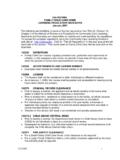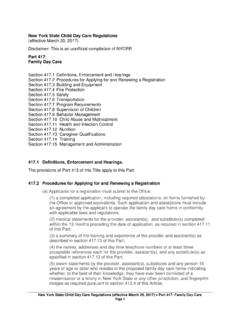Transcription of Protect Your Family From Lead in Your Home
1 ProtectYourFamilyFromLead in YourHomeUnited Sta tes Environmental Protection AgencyUnited Sta tes Consumer Product Saf et y CommissionUnited Sta tes Department of Housing and Urban DevelopmentSeptSeptember 2013 Are You Planning to Buy or Rent a home Built Before 1978?Did you know that many homes built before 1978 have lead-based paint? Lead from paint, chips, and dust can pose serious health this entire brochure to learn: How lead gets into the body About health effects of lead What you can do to Protect your Family Where to go for more informationBefore renting or buying a pre-1978 home or apartment, federal law requires: Sellers must disclose known information on lead-based paint or lead-based paint hazards before selling a house. Real estate sales contracts must include a specific warning statement about lead-based paint. Buyers have up to 10 days to check for lead. Landlords must disclose known information on lead-based paint and lead-based paint hazards before leases take effect.
2 Leases must include a specific warning statement about lead-based undertaking renovations, repairs, or painting (RRP) projects in your pre-1978 home or apartment: Read EPA s pamphlet, The Lead-Safe Certified Guide to Renovate Right, to learn about the lead-safe work practices that contractors are required to follow when working in your home (see page 12).Simple Steps to Protect your Familyfrom Lead HazardsIf you think your home has lead-based paint: Don t try to remove lead-based paint yourself. Always keep painted surfaces in good condition to minimize deterioration. Get your home checked for lead hazards. Find a certified inspector or risk assessor at Talk to your landlord about fixing surfaces with peeling or chipping paint. Regularly clean floors, window sills, and other surfaces. Take precautions to avoid exposure to lead dust when remodeling. When renovating, repairing, or painting, hire only EPA- or state-approved Lead-Safe certified renovation firms.
3 Before buying, renting, or renovating your home , have it checked for lead-based paint. Consult your health care provider about testing your children for lead. your pediatrician can check for lead with a simple blood test. Wash children s hands, bottles, pacifiers, and toys often. Make sure children avoid fatty (or high fat) foods and eat nutritious meals high in iron and calcium. Remove shoes or wipe soil off shoes before entering your Gets into the Body in Many WaysAdults and children can get lead into their bodies if they: Breathe in lead dust (especially during activities such as renovations, repairs, or painting that disturb painted surfaces). Swallow lead dust that has settled on food, food preparation surfaces, and other places. Eat paint chips or soil that contains is especially dangerous to children under the age of 6. At this age, children s brains and nervous systems are more sensitive to the damaging effects of lead.
4 Children s growing bodies absorb more lead. Babies and young children often put their hands and other objects in their mouths. These objects can have lead dust on them. Women of childbearing age should know that lead is dangerous to a developing fetus. Women with a high lead level in their system before or during pregnancy risk exposing the fetus to lead through the placenta during fetal Effects of LeadLead affects the body in many ways. It is important to know that even exposure to low levels of lead can severely harm children, exposure to lead can cause: Nervous system and kidney damage Learning disabilities, attention deficit disorder, and decreased intelligence Speech, language, and behavior problems Poor muscle coordination Decreased muscle and bone growth Hearing damageWhile low-lead exposure is most common, exposure to high amounts of lead can have devastating effects on children, including seizures, unconsciousness, and, in some cases, children are especially susceptible to lead exposure, lead can be dangerous for adults, adults, exposure to lead can cause.
5 Harm to a developing fetus Increased chance of high blood pressure during pregnancy Fertility problems (in men and women) High blood pressure Digestive problems Nerve disorders Memory and concentration problems Muscle and joint pain3 Check your Family for LeadGet your children and home tested if you think your home has s blood lead levels tend to increase rapidly from 6 to 12 months of age, and tend to peak at 18 to 24 months of your doctor for advice on testing your children. A simple blood test can detect lead. Blood lead tests are usually recommended for: Children at ages 1 and 2 Children or other Family members who have been exposed to high levels of lead Children who should be tested under your state or local health screening planYour doctor can explain what the test results mean and if more testing will be Lead-Based Paint Is FoundIn general, the older your home or childcare facility, the more likely it has lead-based homes, including private, federally-assisted, federally-owned housing, and childcare facilities built before 1978 have lead-based paint.
6 In 1978, the federal government banned consumer uses of lead-containing how to determine if paint is lead-based paint on page can be found: In homes and childcare facilities in the city, country, or suburbs, In private and public single- Family homes and apartments, On surfaces inside and outside of the house, and In soil around a home . (Soil can pick up lead from exterior paint or other sources, such as past use of leaded gas in cars.)Learn more about where lead is found at Lead-based paint is currently defined by the federal government as paint with lead levels greater than or equal to milligram per square centimeter (mg/cm), or more than by Lead-containing paint is currently defined by the federal government as lead in new dried paint in excess of 90 parts per million (ppm) by Lead-Based Paint and Lead-Based PaintHazardsDeteriorating lead-based paint (peeling, chipping, chalking, cracking, or damaged paint) is a hazard and needs immediate attention.
7 Lead-based paint may also be a hazard when found on surfaces that children can chew or that get a lot of wear and tear, such as: On windows and window sills Doors and door frames Stairs, railings, banisters, and porchesLead-based paint is usually not a hazard if it is in good condition and if it is not on an impact or friction surface like a dust can form when lead-based paint is scraped, sanded, or heated. Lead dust also forms when painted surfaces containing lead bump or rub together. Lead paint chips and dust can get on surfaces and objects that people touch. Settled lead dust can reenter the air when the home is vacuumed or swept, or when people walk through it. EPA currently defines the following levels of lead in dust as hazardous: 40 micrograms per square foot ( g/ft2) and higher for floors, including carpeted floors 250 g/ft2 and higher for interior window sillsLead in soil can be a hazard when children play in bare soil or when people bring soil into the house on their shoes.
8 EPA currently defines the following levels of lead in soil as hazardous: 400 parts per million (ppm) and higher in play areas of bare soil 1,200 ppm (average) and higher in bare soil in the remainder of the yard Remember, lead from paint chips which you can see and lead dust which you may not be able to see both can be only way to find out if paint, dust, or soil lead hazards exist is to test for them. The next page describes how to do your home for LeadYou can get your home tested for lead in several different ways: A lead-based paint inspection tells you if your home has lead-based paint and where it is located. It won t tell you whether your home currently has lead hazards. A trained and certified testing professional, called a lead-based paint inspector, will conduct a paint inspection using methods, such as: Portable x-ray fluorescence (XRF) machine Lab tests of paint samples A risk assessment tells you if your home currently has any lead hazards from lead in paint, dust, or soil.
9 It also tells you what actions to take to address any hazards. A trained and certified testing professional, called a risk assessor, will: Sample paint that is deteriorated on doors, windows, floors, stairs, and walls Sample dust near painted surfaces and sample bare soil in the yard Get lab tests of paint, dust, and soil samples A combination inspection and risk assessment tells you if your home has any lead-based paint and if your home has any lead hazards, and where both are sure to read the report provided to you after your inspection or risk assessment is completed, and ask questions about anything you do not your home for Lead, continuedIn preparing for renovation, repair, or painting work in a pre-1978 home , Lead-Safe Certified renovators (see page 12) may: Take paint chip samples to determine if lead-based paint is present in the area planned for renovation and send them to an EPA-recognized lead lab for analysis.
10 In housing receiving federal assistance, the person collecting these samples must be a certified lead-based paint inspector or risk assessor Use EPA-recognized tests kits to determine if lead-based paint is absent (but not in housing receiving federal assistance) Presume that lead-based paint is present and use lead-safe work practicesThere are state and federal programs in place to ensure that testing is done safely, reliably, and effectively. Contact your state or local agency for more information, visit , or call 1-800-424-LEAD (5323) for a list of contacts in your Hearing- or speech-challenged individuals may access this number through TTY by calling the Federal Relay Service at You Can Do Now to Protect your FamilyIf you suspect that your house has lead-based paint hazards, you can take some immediate steps to reduce your Family s risk: If you rent, notify your landlord of peeling or chipping paint.


















